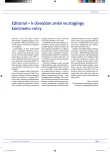Polyneuropathic Pain Therapy with a Patient Suffering from Generalized Castrate‑ Resistant Prostate Cancer – Clinical Case Report
Authors:
L. Holubec 1,2; P. Mrázková 3; V. M. Matějka 2; O. Fiala 2; J. Fínek 2
Authors place of work:
Biomedicínské centrum LF v Plzni, UK v Praze, Plzeň
1; Onkologické a radioterapeutické oddělení, FN Plzeň
2; Klinika zobrazovacích metod LF UK a FN Plzeň
3
Published in the journal:
Klin Onkol 2013; 26(5): 354-357
Category:
Kazuistika
Summary
Background:
Tapentadol is a µ‑ opioid receptors agonist as well as an inhibitor of noradrenaline reuptake. This pharmacologic profile of tapentadol makes it a suitable drug of choice in nociceptive and neuropathic pain control.
Case Report:
This clinical report pressents a 65‑year‑ old man with poorly differentiated prostate cancer – Gleason score 8 (4 + 4) with metastatic bone disease. Besides the initial application of bisphosphonates, the patient had been treated with androgen deprivation therapy (cyproterone acetate + leuprolide acetate) for the period of 18 months. This therapy was terminated due to an increase of PSA levels. Subsequently, the patient underwent palliative docetaxel‑based chemotherapy. There were eight cycles applied with positive clinical and laboratory effect. However, the further application was limited by the averse effects, namely the peripheral neuropathy manifested by pain in arms and legs. The peripheral neuropathy had progressive tendency even after the end of chemotherapy, and supportive treatment with gabapentin and amitryptiline failed to succeed. Four months after zoledronic acid monotherapy, the patient was started on tapentadol in 50-mg dose b.i.d., consequently escalated to 100 mg b.i.d. (to this point, 25 µg of transdermal fentanyl were used for pain management). Significant relief from neuropathic discomfort was observed three weeks from the onset of tapentadol therapy. Patient’s state of health normalized within three months after the initiation of therapy. Consequently, the patient was able to receive docetaxel chemotherapy again, without any neuropathic pain exacerbation on the maintenance dose of tapentadol 50 mg b.i.d.
Conclusion:
Tapentadol administration resulted in stable and long‑time relief from neuropathic pain which is a frequent side effect in the course of castrate‑resistant prostate cancer therapy with taxanes.
Key words: Submitted: Accepted:
case study – tapentadol – neuropathic pain – prostate cancer
Supported by the project ED2.1.00/03.0076 from European Regional Development Fund.
The authors declare they have no potential conflicts of interest concerning drugs, products, or services used in the study.
The Editorial Board declares that the manuscript met the ICMJE “uniform requirements” for biomedical papers.
28. 8. 2013
14. 9. 2013
Zdroje
1. Mercadante S. Cancer pain. Curr Opin Support Palliat Care 2013; 7(2): 139– 143.
2. Laird B, Colvin L, Fallon M. Management of cancer pain: basic principles and neuropathic cancer pain. Eur J Cancer 2008; 44(8): 1078– 1082.
3. Laird BJ, Scott AC, Colvin LA et al. Pain, depression, and fatigue as a symptom cluster in advanced cancer. J Pain Symptom Manage 2011; 42(1): 1– 11.
4. Urch CE, Dickenson AH. Neuropathic pain in cancer. Eur J Cancer 2008; 44(8): 1091– 1096.
5. Fallon MT. Neuropathic pain in cancer. Br J Anaesth 2013; 111(1): 105– 111.
6. Laufenberg‑ Feldmann R, Schwab R, Rolke R et al. Cancer pain in palliative medicine. Anaesthesist 2012; 61(5): 457– 467.
7. Afilalo M, Morlion B. Efficacy of tapentadol ER for managing moderate to severe chronic pain. Pain Physician 2013; 16(1): 27– 40.
8. Clancy J. Cancer‑related neuropathic pain: pharmalogical options. Br J Nurs 2012; 21(17): S31.
9. Stute P, Soukup J, Menzel M et al. Analysis and treatment of different types of neuropathic cancer pain. J Pain Symptom Manage 2003; 26(6): 1123– 1131.
10. Jakubíková H, Klímová E. Neuropatické bolesti onkologických pacientov. Paliat Med Liec Boles 2010; 3(3): 99– 101.
11. Reyes‑ Gibby CC, Morrow PK, Buzdar A et al. Chemotherapy‑induced peripheral neuropathy as a predictor of neuropathic pain in breast cancer patients previously treated with paclitaxel. J Pain 2009; 10(11): 1146– 1150.
12. Jung BF, Herrmann D, Griggs J et al. Neuropathic pain associated with non‑surgical treatment of breast cancer. Pain 2005; 118(1– 2): 10– 14.
13. Dworkin RH, Backonja M, Rowbotham MC et al. Advances in neuropathic pain: diagnosis, mechanisms, and treatment recommendations. Arch Neurol 2003; 60(11): 1524– 1534.
14. Goldstein DJ, Lu Y, Detke MJ et al. Duloxetine vs. placebo inpatients with painful diabetic neuropathy. Pain 2005; 116(1– 2): 109– 118.
15. Rowbotham MC, Goli V, Kunz NR et al. Venlafaxine extended release in the treatment of painful diabetic neuropathy: a double‑blind, placebo‑ controlled study. Pain 2004; 110(3): 697– 706.
16. Durand JP, Deplanque G, Montheil V et al. Efficacy of venlafaxine for the prevention and relief of oxaliplatin‑induced acute neurotoxicity: results of EFFOX, a randomized, double‑blind, placebo‑ controlled phase III trial. Ann Oncol 2012; 23(1): 200– 205.
17. Gaertner J, Schiessl C. Cancer pain management: what‘s new? Curr Pain Headache Rep 2013; 17(4): 328.
18. Taylor R, Pergolizzi JV, Raffa RB. Tapentadol extended release for chronic pain patients. Adv Ther 2013; 30(1): 14– 27.
19. Riemsma R, Forbes C, Harker J et al. Systematic review of tapentadol in chronic severe pain. Curr Med Res Opin 2011; 27(10): 1907– 1930.
Štítky
Dětská onkologie Chirurgie všeobecná OnkologieČlánek vyšel v časopise
Klinická onkologie

2013 Číslo 5
- Metamizol jako analgetikum první volby: kdy, pro koho, jak a proč?
- Nejasný stín na plicích – kazuistika
- Léčba akutní pooperační bolesti z pohledu ortopeda
- Proces hojení ran krok za krokem a co ho může zkomplikovat
- Vysoká hladina PSA a její rychlý nárůst jsou nepříznivými prognostickými faktory u karcinomu prostaty
Nejčtenější v tomto čísle
- Léčba infekcí u pacientů v paliativní symptomatické a terminální fázi onkologického onemocnění
- Chylózní ascites jako závažná komplikace neuroendokrinního tumoru ilea – kazuistika
- Nefroblastom – 30 let léčby ve Fakultní nemocnici v Motole
- Pacientka s atypickým neurocytomem – kazuistika
